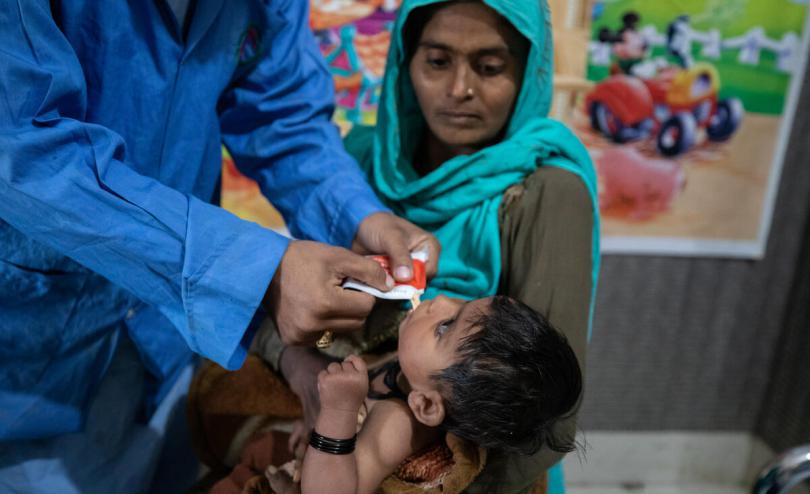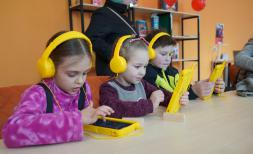“We are barely surviving”: more than six months after deadly Pakistan floods, families are on the brink

Jaiyan*, 10 months old, is treated for severe acute malnutrition at a health clinic supported by Save the Children. Photo by Khaula Jamil/Save the Children. More content available here
Please see a full content package including interviews with and photos of Hajra* and Jaiyan*, Dr Muhammad Hanif, Bashir Ahmed and Waqas: www.contenthubsavethechildren.org/Package/2O4C2SXVFDXF
ISLAMABAD, 9 March 2023 – More than six months after unprecedented floods devastated Pakistan, killing thousands, submerging a third of the country, wiping out livestock and agricultural land and forcing eight million people from their homes[i], children and their families are still living in tents surrounded by stagnant water and surviving on just one meal a day, Save the Children said.
Spiralling inflation is putting food even further out of reach with families forced to cut back on their daily food intake and doctors reporting increased cases of malnutrition. More than a million people are at risk of sliding into emergency levels of hunger, according to the UN[ii].
Communities affected by the floods in Sindh province recently told Save the Children staff how they are barely surviving due to agricultural land – the main income source for most families in the area – being ruined.
Hajra*, 30, lives with her husband and three children in a tent, as their house is still damaged by stagnant flood water. Her husband works as a daily wage labourer and barely earns enough to buy food for one meal per day for the family – usually just bread or curry made from crushed mustard leaves. Due to lack of food, Hajra’s 10-month old baby Jaiyan developed severe acute malnutrition (SAM): she was weak, sick and could no longer breastfeed.
Hajra said: “We had nothing to eat during the rains, and no milk for the children. It was difficult for us to eat the food as our children start crying when they see us eat, so we fed them what we had. There was nothing left to eat for my husband and me. What should we do? Eat and see our children crying and hungry?”
Hajra brought Jaiyan to a healthcare unit run by Save the Children, where she was diagnosed with SAM and provided with medicine and therapeutic treatment. She has improved, but now has moderate acute malnutrition (MAM).
The doctor who treated Jaiyan, Dr Muhammad Hanif, said that the proportion of children under five arriving at his clinic with malnutrition had increased from 20% to 60%. He said: “All the produce that people had from their fields also drowned in the floods so people have absolutely nothing to eat.”
Waqas, 17, lives in a tent with his mother, father and two sisters where he has been since the floods destroyed his home. Before the floods, Waqas and his family were subsistence farmers, with a buffalo, two cows, three goats and up to 12 chickens at a time, who they would breed to sell eggs as well as the animals themselves. From the chicken eggs and buffalo milk, the family used to earn around Rs. 500 (about US$1.80) per day, enough to buy food to feed the family.
But the floods killed all the animals except a few chickens and washed away the family’s source of income. Waqas said: “The floods have had a huge impact on our lives – we used to live a comfortable life by selling what we had, but these days it’s very hard to make ends meet. We lost everything we had to the floods. Everything we relied on for financial support is gone.”
“The conditions are terrible after the floods – people don’t even have the luxury of one basic meal. After losing their homes to the floods, all the villagers are in deep torment. Everyone is worrying about how to rebuild our homes with almost no resources and extreme cold. We are barely surviving. We don’t even have blankets or warm clothes to save ourselves from the cold.”
Bashir, 52, is a vegetable seller with five children. He now has to travel much further to find vegetables to sell in his cart, and inflation is pushing up prices, and pushing away potential customers.
He said: “Before the floods, I was able to provide the children with all the amenities that they needed for a good life. We were able to afford vegetables and meat, at intervals we would also buy fish. We were able to afford fruits like grapes, bananas and different seasonal fruits. Now we eat basic lentils and some basic vegetables. We just eat enough so we can stay alive, we only eat twice a day now unlike old times, where we could afford to eat three times a day.”
“It has become so painful because when the children return to the tent at night, they cry and scream that they want to live in a proper house, and ask me to take them to the neighbour’s houses. I do not know how they will go forward in life. I just do not have the resources to manage my children’s lives any more, it is difficult to just survive since the rains.”
With 33 million people, including 16 million children, still in need[iii], and the UN’s Pakistan Floods Response Plan just 36% funded more than halfway through its nine-month duration[iv], Save the Children called on the international community to urgently step up funding to prevent a full-scale hunger crisis that will see children starve and malnutrition skyrocket.
There also needs to be tangible progress on the agreement at last year’s COP27 climate summit to establish a Loss and Damage fund, with funds clearly earmarked for climate disasters such as that experienced by Pakistan, as well as slow-onset events like rising sea levels, Save the Children said.
Khuram Gondal, Save the Children Country Director for Pakistan, said:
“This is one of the biggest disasters this country has ever seen, and after six months, we are still suffering. These devastating floods are an acute example of how those living in a country responsible for less than 1% of global carbon emissions are seeing their lives completely turned upside down by the climate crisis – and as with all disasters, children are bearing the brunt. This is at its core a child’s rights crisis – and in this instance, it is the rights and the lives of 16 million children. Yet international donors have not even produced half the funding desperately needed to keep children and their families going.
“When will the world listen to these children? We welcome the fact that some steps have been taken – but children in Pakistan need more, not only to rebuild from this catastrophe but also to know that in future, when they will inevitably bear the brunt of yet more climate disasters, the world will not look away.”
ENDS
*Names changed to protect privacy
NOTES TO EDITORS
- Save the Children has been working in Pakistan since 1979, since when it has reached more than 14 million children and families with health and nutrition, education, child protection, livelihoods and humanitarian response programmes.
- Since the devastating floods in 2022, Save the Children has reached 133,741 children and families across food security, education, health, nutrition, water, sanitation and hygiene. In Sindh province, Save the Children continues to support affected families through the distribution of cash, health and nutrition treatment and livelihood recovery programmes.
Please see a full content package including interviews with and photos of Hajra* and Jaiyan*, Dr Muhammad Hanif, Bashir Ahmed and Waqas: www.contenthubsavethechildren.org/Package/2O4C2SXVFDXF
[i] UN OCHA Humanitarian Response Plan, October 2022 Pakistan Floods 2022 - Floods Response Plan - Revision - 04 Oct 2022.pdf
[iii] World Food Programme, February 2023 20230213 PAK External SitRep.pdf
[iv] Pakistan Floods Response SitRep No.14 As of 6 Feb 2023.pdf
For further enquiries and media spokespeople please contact Emily Wight: Emily.Wight@savethechildren.org
Our media out of hours contact is media@savethechildren.org.uk / +44(0)7831 650409
Please also check our Twitter account @Save_GlobalNews for news alerts, quotes, statements and location Vlogs.




